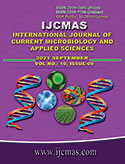


 National Academy of Agricultural Sciences (NAAS)
National Academy of Agricultural Sciences (NAAS)

|
PRINT ISSN : 2319-7692
Online ISSN : 2319-7706 Issues : 12 per year Publisher : Excellent Publishers Email : editorijcmas@gmail.com / submit@ijcmas.com Editor-in-chief: Dr.M.Prakash Index Copernicus ICV 2018: 95.39 NAAS RATING 2020: 5.38 |
A field experiment on influence of intercropping on the larval population of chickpea pod borer, Helicoverpa armigera (Hub.) in chickpea was conducted at Agricultural Research Farm of Brahmanand Post Graduate College, Rath, Hamirpur, Uttar Pradesh during 2016-17 and 2019-20. In Bundelkhand agro-climatic region the activity of chickpea pod borer was observed from last week of December to last week of March while, its peak activity was noticed at 9th, 10th and 11th SMW in chickpea agro-ecosystem. The infestation of chickpea pod borer (H. armigera) larvae was started from last week of December when the crop was in vegetative growth stage. Thereafter, its population increase gradually to reach maximum (1.72 larvae/mrl) at 10th standard (first fortnight of March) after that its population declined gradually till the harvesting of the crop. The chickpea intercropped with safflower, mustard, linseed, barley and marigold had significant influence in reducing the larval population of chickpea pod borer (H. armigera). The chickpea intercropped with marigold (0.71larva/mrl) and mustard (0.75larva/mrl) was found the most effective in reducing the larval population of H. armigera. It was followed by chickpea + linseed, chickpea + barley and chickpea + safflower intercropping systems. The maximum population of chickpea pod borer was observed in chickpea sole crop (1.07larvae/mrl).
 |
 |
 |
 |
 |